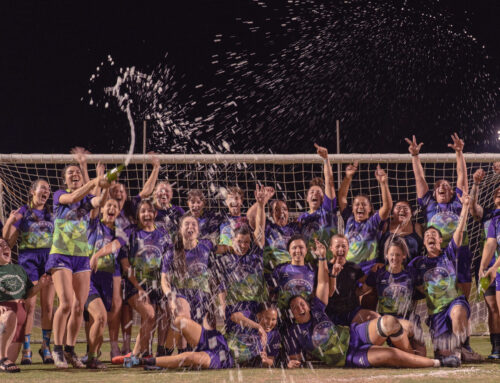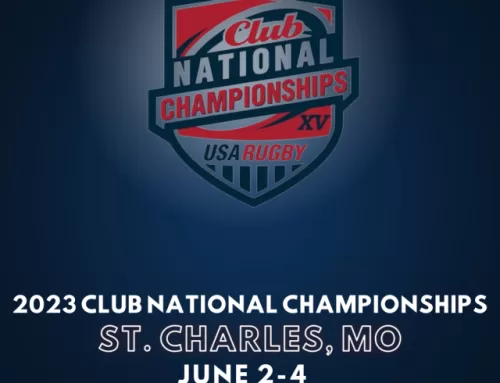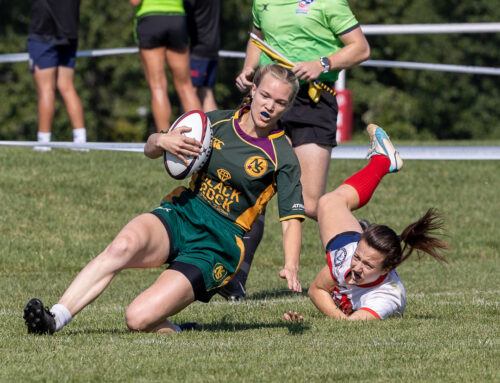
General
The goal in rugby is to score tries, which involves running into the try zone (like an end zone) and touching the ball to the ground. To do so, you can only pass backward or lateral and may advance through running and kicking. Offensively, the we move and pass to create gaps in the defense. Defensively, we stay together as a flat line to minimize gaps.
Vocabulary
Lineout: Lineouts restart play after the ball, or a player carrying it, has gone out of bounds. Both teams line up opposite each other and typically lifts a player into the air. The ball is thrown down the middle of the tunnel between the teams by the team who did not carry the ball out.
Ruck: When a tackle occurs, the tackler must release the tackled player, and the tackled player must release the ball. When the ball is released, a contest for possession occurs called a ruck. A ruck usually involves an offensive player who stands over the ball to retain possession and a defensive player trying to push them over the ball.
Scrum: Scrums restart play after minor infractions. Eight players from each team bind together and push each other while the ball is rolled on the ground between them. The 8 push against the opposition’s 8 to gain possession of the ball.
Field Positions
Forwards
Props: #1 and #3
Props are normally the biggest two players on the team and must use their size and strength to win the ball during a scrum. In open play, props should be able to draw several defenders in through strong runs to create space for others, and be able to retain possession through rucking.
Hooker: #2
In a scrum, the hooker puts their arms over the top of the props’ shoulders and will be supported by their weight. They are responsible for “hooking” the ball back toward our team using their foot as the rest of the scrum pushes forward. In open play, they must be strong and mobile, and ideally should be able to throw in lineouts.
Locks: #4 and #5
These players are typically some of the tallest and strongest on the team. They use their strength to drive the scrum forward and often jump in lineouts. In open play, similar to the props, they must be able to run through defenders and draw more in to create gaps in the defense and retain possession through strong rucks.
Flankers: #6 and #7
In the scrum, flankers are known as “loose forwards” because they are on the sides and not tightly bound in. When the scrum is over, flankers are the first ones out to either make the first tackle or secure possession through rucking. Flankers should be great all-around players who specialize in tackling, but can also run, pass, and catch effectively.
The 8-Man: #8
The 8-man is on the very back end of the scrum and is also considered a loose forward. During a scrum, the 8-man should have good field vision, be able to control the ball in the scrum, and be ready to break away quickly. 8s are typically big but mobile players with great decision-making and ball skills.
Backs
Scrumhalf: #9
The scrum half is the primary distributor on the team. In open play, scrum halves follow the ball distribute the ball after a tackle occurs. In scrums, the scrum half puts the ball in and distributes it once secured. Scrum halves are usually small players with great endurance, great passes, and good field vision. Must be able to listen to the #10 and execute on what is needed.
Flyhalf: #10
The fly half is something like the quarterback in football. Most importantly, they are calling the plays and directing the offense as well as distributing the ball, so must have great field vision and be confident in decision-making. They must have great hands to catch passes from the scrum half and then be able to quickly transfer the ball to the rest of the offense. Ideally, the fly half should also be one of the team’s best kickers to gain territory or clear up space.
Centers: #12 and #13
#12 is called the inside center and is a very hard and powerful runner on offense and loves to tackle, but can also catch and pass very well. They should have strong runs that draw in defenders and create space on the outside.
#13 is the Outside Center. Outside centers are typically fast and evasive, but also great distributors and decision-makers when there is space toward the edge of the field. A good outside can draw defenders in to make space for their wing, or take advantage of gaps already created through good footwork.
Wings: #11 and #14
Wings should be the fastest sprinters on the team as well as good in 1:1 tackles. Offensively, many plays and moves are meant to suck defenders into the middle and create running space for the wings. Good footwork is important as well as field vision.
Fullback: #15
On defense, a fullback is the last resort when an offensive player breaks through. They must have great open field and 1:1 tackles. They should also be able to catch high kicks and be able to punt. Offensively, they are a flexible, unpredictable player who can identify gaps and run fast in open space.



